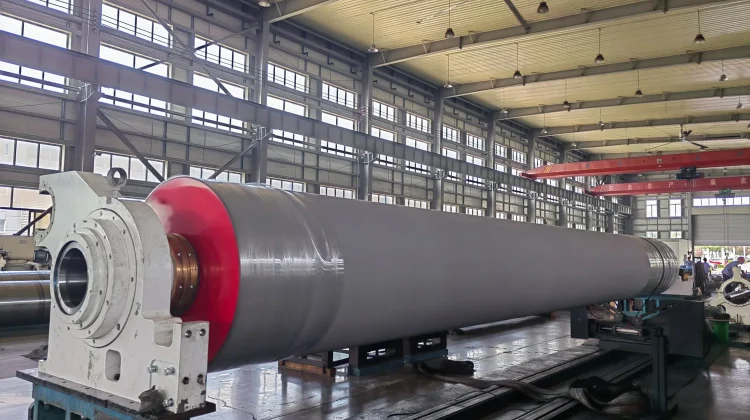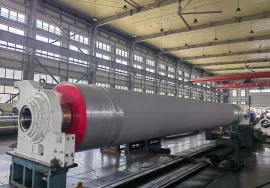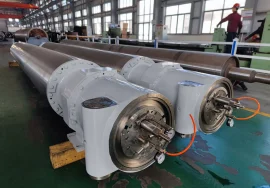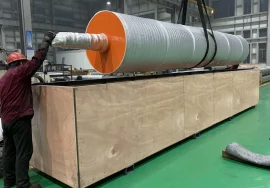
Extend Paper Machine Roll Lifespan: Essential Maintenance Strategies
Paper machine rolls are arguably the heart of paper production. These cylindrical components, varying in size and function from press rolls and couch rolls to calendar rolls and reel spools, endure immense pressure, heat, and corrosive environments. Their performance and longevity are directly tied to a paper mill’s efficiency, product quality, and operational costs. A roll failure can bring an entire line to a halt, leading to significant downtime and lost revenue. Conversely, effectively extending their lifespan through diligent care isn’t just about avoiding breakdowns; it’s about optimizing performance over time, ensuring consistent paper quality, and achieving a more sustainable operational model. This isn’t merely a technical challenge; it’s a strategic imperative for any mill aiming for peak profitability and reliability in a competitive market. To be honest, neglecting roll maintenance is like ignoring the health of your most critical asset.
Understanding the Factors Limiting Paper Machine Roll Lifespan
Why do paper machine rolls eventually need replacement or extensive refurbishment? The answer lies in a combination of operational stresses and environmental factors inherent in the paper manufacturing process. Mechanical wear is perhaps the most obvious culprit. Rolls are subjected to constant friction, high nip pressures (especially in press sections), and dynamic loads, leading to surface wear, deformation, and fatigue. Corrosion is another significant issue; the moist, often chemically aggressive environment within the paper machine can degrade roll materials, particularly metallic components, and compromise protective coatings. Thermal stress from hot processes like drying can cause material expansion and contraction, leading to cracking or debonding of coatings or covers. Additionally, operational issues like improper alignment, vibration, tramp materials entering the nip, or even inconsistent paper web tension can induce excessive stress on the rolls, accelerating wear and potentially causing catastrophic failure. Understanding these pervasive threats is the foundational step in developing effective strategies to **extend paper machine roll lifespan**.
Implementing Proactive Preventative Maintenance for Longevity
One of the most impactful **essential maintenance strategies** for paper machine rolls is a robust preventative maintenance program. This goes far beyond simply reacting to issues as they arise. It involves scheduled inspections, cleaning routines, lubrication schedules, and minor adjustments designed to identify and mitigate potential problems *before* they escalate. Regular visual inspections can spot early signs of wear, cracking, pitting, or coating damage. Cleaning is crucial to remove fiber buildup, chemical residues, and debris that can cause uneven wear or surface imperfections. Proper lubrication of bearings and seals is absolutely non-negotiable; inadequate lubrication is a leading cause of bearing failure, which can quickly damage the roll journal and compromise overall roll integrity. Interestingly enough, the simple act of following a strict lubrication schedule with the correct lubricant for the application can add years to a roll’s service life. Think of preventative maintenance as routine health check-ups for your rolls – catching small issues early prevents major, costly problems down the line.
Routine Inspection and Cleaning Protocols
Diving deeper into preventative actions, specific protocols for inspection and cleaning are paramount. Detailed checklists should be developed for different types of rolls, outlining what to look for (e.g., surface condition, bearing housing integrity, seal condition, signs of corrosion or overheating). These inspections should occur at regular intervals, perhaps during scheduled shutdowns or even brief operational pauses where safe. Cleaning procedures must address the specific contaminants encountered, utilizing appropriate methods and chemicals that won’t damage the roll surface or coatings. For example, high-pressure water jets might be effective for removing fiber, but chemical cleaning requires careful selection to avoid material degradation. Franky speaking, inconsistent or improper cleaning can actually *harm* the roll, accelerating wear or damaging protective layers. It’s worth noting that documenting these inspections and cleaning activities provides valuable historical data for tracking wear patterns and predicting future maintenance needs, further aiding efforts to **extend paper machine roll lifespan**.
Leveraging Condition Monitoring for Early Anomaly Detection
While preventative maintenance operates on a schedule, condition monitoring adds a crucial layer of predictive capability, allowing mills to **extend paper machine roll lifespan** by detecting anomalies in real-time or near real-time. Techniques such as vibration analysis, thermal imaging (thermography), and acoustic monitoring can reveal underlying issues long before they become visually apparent or cause operational problems. Increased vibration levels can indicate bearing wear, imbalance, or structural issues. Hot spots detected via thermal imaging might point to excessive friction, lubrication issues, or electrical problems in associated equipment. Acoustic monitoring can pick up unusual noises indicative of internal damage. By continuously or periodically monitoring these parameters, maintenance teams can transition from scheduled repairs to condition-based maintenance, addressing problems precisely when needed, optimizing repair timing, and preventing minor issues from causing catastrophic failures. Have you ever wondered how some mills seem to anticipate failures? It’s often through sophisticated condition monitoring programs.
Implementing Vibration and Thermal Analysis
Implementing vibration analysis involves attaching sensors to roll bearing housings to measure vibration amplitude and frequency. Changes in the vibration signature can be analyzed to diagnose specific problems like bearing defects, misalignment, or resonance issues. Baseline data is established for healthy rolls, and deviations trigger alerts. Similarly, thermal imaging uses infrared cameras to measure surface temperatures. Abnormal temperature distributions or elevated temperatures can highlight areas of concern, such as inadequate lubrication in bearings, friction from failing seals, or even issues within internal cooling/heating systems of temperature-controlled rolls. I’ve found that a combination of vibration analysis and thermography provides a powerful one-two punch for early detection of many common roll problems. This data-driven approach allows for targeted intervention, minimizing unnecessary downtime and maximizing the time a roll remains in peak operating condition, thereby significantly contributing to **extending paper machine roll lifespan**.
Optimizing Roll Handling, Storage, and Operational Practices
It’s not just about the roll’s time in the machine; how rolls are handled, stored, and operated day-to-day also profoundly impacts their longevity. Improper handling during transport or installation can lead to dents, surface damage, or journal damage. Using incorrect lifting equipment or techniques is a common pitfall. Similarly, storage conditions are vital. Rolls should be stored horizontally on proper supports, away from moisture, extreme temperatures, and corrosive chemicals. Rotating stored rolls periodically helps prevent deformation or bearing brinelling. Beyond handling and storage, operational practices within the paper machine itself play a huge role in **extending paper machine roll lifespan**. Maintaining proper nip pressure profiles, ensuring correct roll alignment, and minimizing sudden starts and stops or excessive speeds beyond designed limits are critical. Avoiding the ingress of tramp materials (like nuts, bolts, or debris) into the roll nips is essential to prevent surface damage and potential roll failure. Operator training on best practices for roll care and machine operation directly translates into improved roll longevity.
Strategic Refurbishment and Repair for Extended Service Life
Inevitably, even with the best preventative and predictive maintenance, rolls will experience wear and damage over time. At this point, strategic refurbishment and repair become essential strategies for **extending paper machine roll lifespan**. Rather than immediate replacement, which is often expensive, a damaged roll can frequently be restored to its original specifications or even improved. Common refurbishment activities include grinding or turning the roll surface to remove wear or restore cylindrical profile, repairing damaged journals or bearing seats, replacing worn covers or coatings, and balancing the roll to eliminate vibration. The key is timely intervention. Addressing wear or damage early through planned refurbishment cycles is far more cost-effective than waiting for a critical failure. Choosing the right repair facility with the expertise and equipment to handle large paper machine rolls accurately is also paramount; substandard repairs can do more harm than good. A well-executed refurbishment can give a roll a new lease on life, delaying the need for a complete capital investment in a replacement roll.
Considering Roll Covers and Coatings
Roll covers and coatings are integral to the performance and longevity of many paper machine rolls. They provide specific surface properties (like hardness, elasticity, release characteristics), protect the underlying roll body from wear and corrosion, and can often be reground or replaced as they wear. Selecting the appropriate cover material for a given application (e.g., rubber, polyurethane, composite, ceramic, chrome) is critical, as is ensuring proper application and maintenance of the cover. Monitoring cover wear and condition, and adhering to recommended regrinding schedules, prevents the cover from wearing through to the roll body, thus protecting the primary asset. When covers reach the end of their useful life, prompt and correct stripping and recovering procedures are necessary. Many experts agree that staying current with advancements in roll cover technology and materials is another way to potentially **extend paper machine roll lifespan** and enhance performance.
Selecting the Right Partners for Roll Maintenance and Refurbishment
Implementing comprehensive maintenance strategies for paper machine rolls is a significant undertaking, often requiring specialized expertise and equipment. This is where selecting the right external partners becomes a vital part of the strategy. Companies specializing in paper machine roll maintenance and refurbishment can offer services ranging from advanced condition monitoring and on-site inspections to precision grinding, balancing, and complete roll overhauls. They often possess the necessary technical knowledge regarding various roll types, materials, and failure modes. Partnering with a reputable provider ensures access to state-of-the-art repair techniques, quality materials for covers and coatings, and experienced technicians. These partnerships can supplement a mill’s internal capabilities, particularly for complex repairs or specialized testing, ultimately contributing to more effective maintenance and a longer, more productive life for critical rolls. We, for example, offer a range of services specifically designed to help mills achieve these goals, leveraging decades of experience in roll care.
Investing in Technology and Training for Enhanced Roll Care
Beyond external partnerships, internal investment in technology and workforce training is crucial for maximizing the effect of maintenance strategies. This includes acquiring modern tools for inspection, cleaning, and lubrication, as well as potentially investing in advanced condition monitoring systems. Furthermore, ongoing training for maintenance staff and machine operators on best practices for roll handling, operation, and basic inspection is indispensable. A well-trained team is better equipped to identify early warning signs, perform routine tasks correctly, and understand the impact of their actions on roll longevity. This investment in human capital and technology pays dividends by reducing the frequency and severity of roll failures and optimizing the timing of scheduled maintenance, reinforcing all efforts to **extend paper machine roll lifespan**. Are your maintenance staff fully trained on the latest techniques for roll inspection and care? It’s a question worth considering.
In conclusion, **extending paper machine roll lifespan** is not a single action but a holistic approach encompassing proactive prevention, intelligent monitoring, careful handling, operational discipline, and strategic refurbishment. By implementing these **essential maintenance strategies** – regular inspections, timely lubrication and cleaning, leveraging condition monitoring technologies, ensuring proper handling and storage, and utilizing expert refurbishment services – paper mills can significantly reduce downtime, lower maintenance costs, improve machine efficiency, and maintain consistent product quality. Focusing on the health and longevity of these critical components is an investment that yields substantial returns, securing the operational reliability essential for success in the paper industry. A proactive stance today ensures sustained performance and profitability tomorrow.
For more detailed information, please visit our official website: Extend Paper Machine Roll Lifespan: Essential Maintenance Strategies





